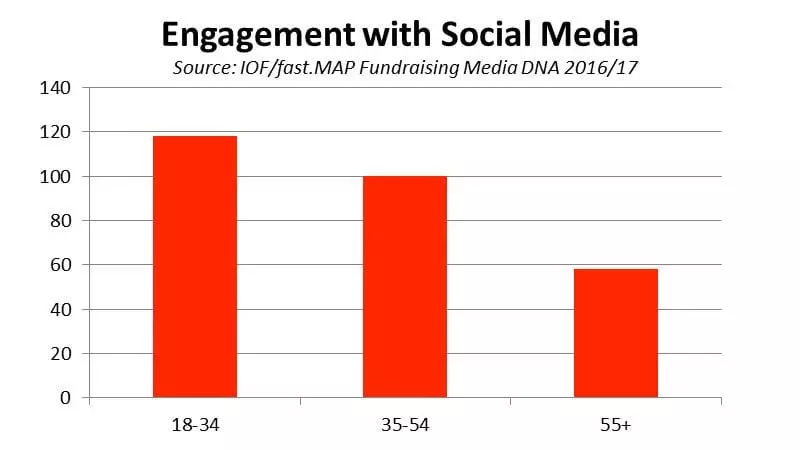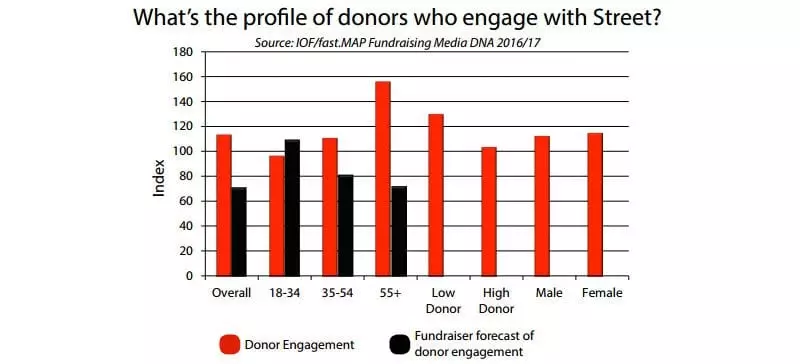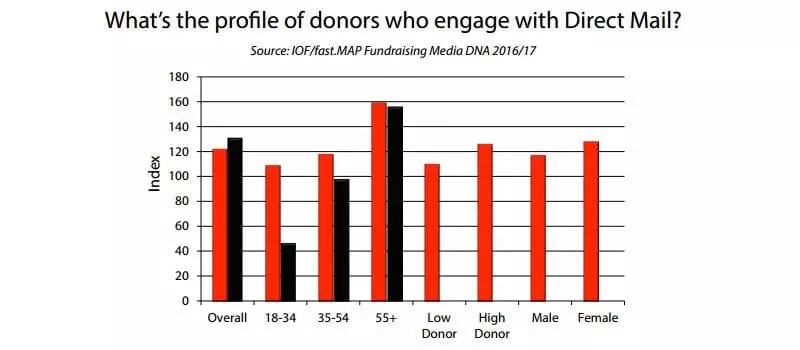Fundraising Media DNA 2016/17: effectively targeting different age groups
Whether a charity is seeking to target a specific age group or a range of ages, they are due to benefit from understanding the attitudes and behaviours that different age groups exhibit towards fundraising channels.
To help charities acquire such an understanding, the Institute of Fundraising and fast.MAP recently launched Fundraising Media DNA 2016/17, which looks into how different age groups engage, perceive and respond to various fundraising channels.
Engagement
Findings show that DRTV, direct mail and email are the top channels with which all of the studied age groups engage.
As expected by fundraisers, social media is also one of the channels that 18-34 year olds engage with the most (Engagement Index; 18-34, Actual 118 vs. Fundraisers’ expectation, 225).

Source: IoF/fast.MAP Fundraising Media DNA 2016/17
Social media is also quite popular, in terms of engagement, amongst 35-54 year olds (Engagement Index; 35-54, 100).
55+s aren’t as engaged with Social Media as younger age groups are (Engagement Index; 55+, 58).
Instead, 55+s are highly engaged with Street fundraising (Engagement Index; 55+, 155) – a channel which 18-34s find less engaging (Engagement Index; 18-34, 96).

Source: IoF/fast.MAP Fundraising Media DNA 2016/17
Perceptions and Responses
DRTV
DRTV scores highly for many positive attributes across all age groups. Being ‘attention-grabbing’, ‘memorable’ and ‘attractive’ were the attributes for which it was ranked the highest across all ages.
Thus, DRTV seems like an ideal channel to use for charities that wish to appeal to both ends of the age spectrum.
35-54 year olds and 55+s also rank DRTV highly for being ‘interesting’ (Interesting Index; 35-54, 113; 55+, 145). 18-34 year olds do not seem to share this perception (Interesting Index; 18-44, 98). They find it more ‘authoritative’ (Authoritative Index; 18-34, 115 vs. 34-54, 106). This is interesting to know as it suggests that messages delivered via TV ads are likely to be respected, taken seriously and perhaps, obeyed by this age group.
This idea is supported with findings which show that 18-34 year olds are the mostly likely to donate or respond immediately to DRTV (Donate/Respond Now Index; 18-34, vs. 95 vs. 35-54, 89; 55+, 91).

Source: IoF/fast.MAP Fundraising Media DNA 2016/17
Advertisement
Direct Mail
Being ‘retainable’ was the attribute that was ranked the highest across all ages in regards to perceptions of direct mail (Retainable Index; 18-34 vs. 136; 34-54, 152 vs. 55+. 149).
All age groups also perceive direct mail as highly ‘trustworthy’ (Trustworthy Index; 18-34 139 vs. 34-54, 130 vs. 55+. 145).
Direct mail is generally perceived quite positively and is even considered a preferred channel, particularly amongst 55+s and 18-34 year olds (Preferred Channel Index; 18-34, 138; 55+, 176).
Not only do young people prefer direct mail, they also welcome it (Welcome Index; 18-34, 153). Direct mail seems to have more appeal to younger audiences than fundraisers expect (Engagement Index; 18-34 Actual 109 vs. Expectation 47).

Source: IoF/fast.MAP Fundraising Media DNA 2016/17
While direct mail is popular amongst 55+s, as fundraisers predict, it is also popular with young groups. Findings even show that 18-34s are more likely to donate or respond immediately (Donate/Respond Now; 18-34, 97 vs. 35-54 vs. 92; 55+, 93), research further (Research; 18-34, 101 vs. 55+, 97) and share (Share; 18-34, 102 vs. 35-54, 90; 55+, 73) in response to Direct Mail than older groups are.
‘Preferred Channel’ was the attribute that all age groups ranked the highest in association with email (Preferred Channel Index; 18-34, 204; 35-54, 211; 55+, 264). Email also scores well across all age groups for being ‘personalised’,’ convenient’, ‘easy to respond to’ and ‘retainable’.

Source: IoF/fast.MAP Fundraising Media DNA 2016/17
55+s, in particular, perceive email as being ‘easy to share’ (Easy to Share Index; 55+, 135 vs. 35-54, 114; 18-34, 106). This correlates with findings which reveal that they are also more likely to share as an action in response to receiving fundraising emails than younger age groups are (Share Index; 55+, 103 vs. 18-34, 99).
The most popular response to email amongst younger age groups is ‘researching further’ (Research Index; 18-34, 102). As research further is a strong response amongst this age group, it is important that fundraisers targeting 18-34s create and present opportunities to do so in their email campaigns.
Expert views on fundraising to different age groups
“The findings from this research show that we should never take ‘accepted wisdom’ at face value. The response and engagement to different communication channels from people in different age groups is complex, and it’s important that fundraisers don’t fall into the trap of making assumptions.”
Daniel Fluskey, Head of Policy and Research, Institute of Fundraising
“More traditional media, such as direct mail, press and inserts, still play a key role in engaging a wide range of audiences, including younger donors as well as the over 55s. However, email is also seen as being welcomed by the over 55s and is developing a stronger preference for being one of donors’ preferred communication channels.”
David Cole, Managing Director, fast.MAP
“Direct mail scores highly with the over-55s as ‘my preferred way to hear from a charity’ which may be because many people find that direct mail is less intrusive than some other media. It also surprisingly scores highly with the 18 to 34 groups which may be due to ensuring the mailing is relevant to the recipient and considered to have ‘interesting content’. Understanding your existing and prospective donors and respecting their wishes is crucial to success.”
Claire Gingell, Marketing Manager, ONEPOST
Further insight
Fundraising campaigns can be tailored to be more efficient and effective for different age groups when assumptions and generalisations aren’t made, but instead, research is conducted.
To find out more about how people view and interact with different fundraising channels, download Fundraising Media DNA 2016/17 – free (normally £50) with the following code: UKFU16.



